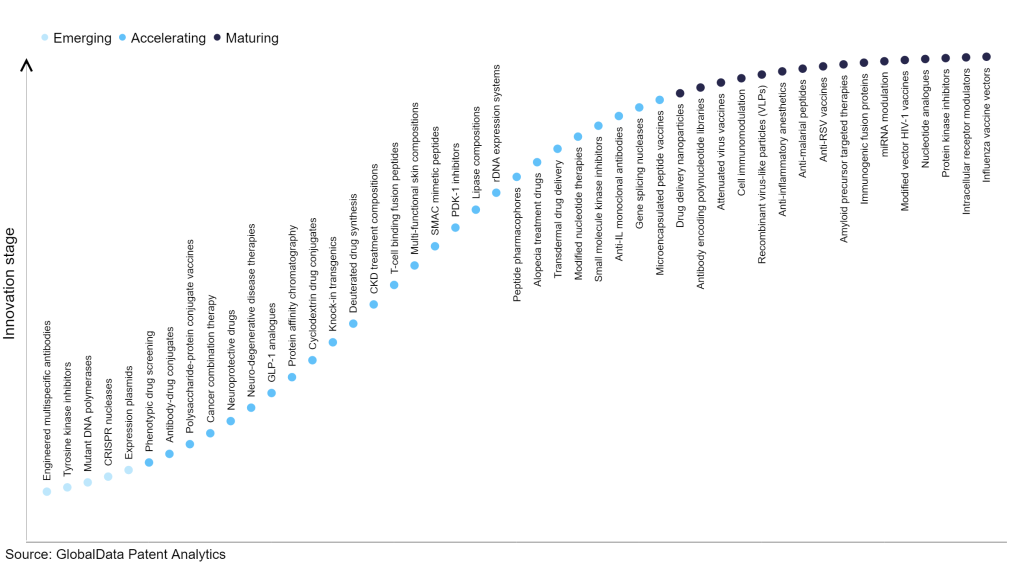The pharmaceutical industry continues to be a hotbed of patent innovation. Activity is driven by the evolution of treatment paradigms, and the gravity of unmet needs, as well as the growing importance of technologies such as pharmacogenomics, digital therapeutics, and artificial intelligence. In the last three years alone, there have been over 787,000 patents filed and granted in the pharmaceutical industry, according to GlobalData’s report on Innovation in pharma: antibody-drug conjugates. Buy the report here.
However, not all innovations are equal and nor do they follow a constant upward trend. Instead, their evolution takes the form of an S-shaped curve that reflects their typical lifecycle from early emergence to accelerating adoption, before finally stabilizing and reaching maturity.
Identifying where a particular innovation is on this journey, especially those that are in the emerging and accelerating stages, is essential for understanding their current level of adoption and the likely future trajectory and impact they will have.
80+ innovations will shape the pharmaceutical industry
According to GlobalData’s Technology Foresights, which plots the S-curve for the pharmaceutical industry using innovation intensity models built on over 668,000 patents, there are 80+ innovation areas that will shape the future of the industry.
Within the emerging innovation stage, engineered multi-specific antibodies, tyrosine kinase inhibitors, and mutant DNA polymerases are disruptive technologies that are in the early stages of application and should be tracked closely. Phenotypic drug screening, antibody-drug conjugates, and polysaccharide-protein conjugate vaccines are some of the accelerating innovation areas, where adoption has been steadily increasing. Among maturing innovation areas are drug delivery nanoparticles and antibody encoding polynucleotide libraries, which are now well established in the industry.
Innovation S-curve for the pharmaceutical industry

Antibody-drug conjugates is a key innovation area in the pharmaceutical industry, particularly in the field of oncology
Antibody-drug conjugates (ADCs) are a type of targeted cancer therapy that combine the specificity of monoclonal antibodies (mAbs) with the cytotoxic effects of chemotherapeutic drugs. In an ADC, a mAb is linked to a cytotoxic drug molecule, which is then delivered directly to cancer cells via the antibody's specific binding site. The approach allows for more precise targeting of cancer cells and is anticipated will minimize the side effects of chemotherapy.
GlobalData’s analysis also uncovers the companies at the forefront of each innovation area and assesses the potential reach and impact of their patenting activity across different applications and geographies. According to GlobalData, there are 340+ companies, spanning technology vendors, established pharmaceutical companies, and up-and-coming start-ups engaged in the development and application of antibody-drug conjugates.
Key players in antibody-drug conjugates – a disruptive innovation in the pharmaceutical industry
‘Application diversity’ measures the number of applications identified for each patent. It broadly splits companies into either ‘niche’ or ‘diversified’ innovators.
‘Geographic reach’ refers to the number of countries each patent is registered in. It reflects the breadth of geographic application intended, ranging from ‘global’ to ‘local’.
Patent volumes related to antibody-drug conjugates
| Company | Total patents (2010 - 2022) | Premium intelligence on the world's largest companies |
| F. Hoffmann-La Roche | 2200 | Unlock Company Profile |
| Gilead Sciences | 476 | Unlock Company Profile |
| AbbVie | 464 | Unlock Company Profile |
| Pfizer | 430 | Unlock Company Profile |
| Ganymed Pharmaceuticals | 428 | Unlock Company Profile |
| Amgen | 423 | Unlock Company Profile |
| Daiichi Sankyo | 403 | Unlock Company Profile |
| Astellas Pharma | 355 | Unlock Company Profile |
| Bristol-Myers Squibb | 334 | Unlock Company Profile |
| ImmunoGen | 304 | Unlock Company Profile |
| AstraZeneca | 280 | Unlock Company Profile |
| Seagen | 267 | Unlock Company Profile |
| Mereo BioPharma 5 | 249 | Unlock Company Profile |
| Immatics | 231 | Unlock Company Profile |
| Johnson & Johnson | 223 | Unlock Company Profile |
| Regeneron Pharmaceuticals | 207 | Unlock Company Profile |
| Philogen | 207 | Unlock Company Profile |
| Stemcentrx | 173 | Unlock Company Profile |
| Oxford BioTherapeutics | 169 | Unlock Company Profile |
| GSK | 148 | Unlock Company Profile |
| Takeda Pharmaceutical | 142 | Unlock Company Profile |
| Sanofi | 137 | Unlock Company Profile |
| TRON | 131 | Unlock Company Profile |
| Novartis | 111 | Unlock Company Profile |
| Memorial Sloan Kettering Cancer Center | 108 | Unlock Company Profile |
| Eureka Therapeutics | 102 | Unlock Company Profile |
| Merck | 100 | Unlock Company Profile |
| Prothena | 96 | Unlock Company Profile |
| Sorrento Therapeutics | 85 | Unlock Company Profile |
| Mayo Clinic | 82 | Unlock Company Profile |
| Centre National de la Recherche Scientifique | 81 | Unlock Company Profile |
| ADC Therapeutics | 80 | Unlock Company Profile |
| C. H. Boehringer Sohn | 80 | Unlock Company Profile |
| Royal Caribbean Cruises | 77 | Unlock Company Profile |
| Axon Neuroscience | 71 | Unlock Company Profile |
| Alethia Biotherapeutics | 68 | Unlock Company Profile |
| Bayer | 64 | Unlock Company Profile |
| Zymeworks | 62 | Unlock Company Profile |
| Academia Sinica | 59 | Unlock Company Profile |
| Seven and Eight Biopharmaceuticals | 59 | Unlock Company Profile |
| National Research Council of Canada | 58 | Unlock Company Profile |
| National Cancer Center | 58 | Unlock Company Profile |
| OBI Pharma | 58 | Unlock Company Profile |
| MacroGenics | 58 | Unlock Company Profile |
| Chiome Bioscience | 57 | Unlock Company Profile |
| Siwa | 56 | Unlock Company Profile |
| CytomX Therapeutics | 56 | Unlock Company Profile |
| Jiangsu Hengrui Medicine | 54 | Unlock Company Profile |
| Abbott Laboratories | 53 | Unlock Company Profile |
| Adicet Bio | 53 | Unlock Company Profile |
Source: GlobalData Patent Analytics
F. Hoffmann-La Roche is one of the leading patent filers in antibody-drug conjugates. The lead ADCs are Kadcyla and Polivy, which are currently approved in multiple countries for select cancers. The company has filed several patents and is currently investing in the development of several other pipeline candidates that fall under the ADC class.
In terms of application diversity, AbbVie leads the pack, while Siwa and Takeda stood in the second and third positions, respectively. By means of geographic reach, Axon Neuroscience held the top position, followed by Daiichi Sankyo and Immatics.
To further understand the key themes and technologies disrupting the pharmaceutical industry, access GlobalData’s latest thematic research report on Pharmaceutical.
Premium Insights
From

The gold standard of business intelligence.
Blending expert knowledge with cutting-edge technology, GlobalData’s unrivalled proprietary data will enable you to decode what’s happening in your market. You can make better informed decisions and gain a future-proof advantage over your competitors.







